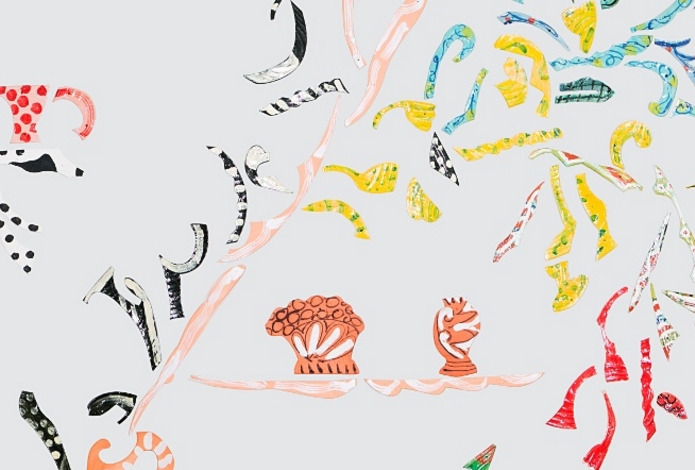Betty Woodman: Theatre of the Domestic, 3 February – 10 April 2016, !CA London
This first UK solo presentation and survey of Betty Woodman’s last 15 years of activity is a timely show given the current resurgence in ceramics by contemporary artists working with clay, including London-based Emma Hart, Caroline Achaintre, and organisations like Troy Town Art Pottery and The Grantchester Pottery, just to name a few. Contrary though to most of this younger generation, who discovered clay after first working with other materials, Woodman (b. 1930, Connecticut, USA) started making tableware as a teenager and, after a career as an innovative potter, started to identify entirely as a sculptor in the 1980s.
Whereas from the 1950s ‘Abstract Expressionist Ceramics’, a title given to the work of a group of West Coast American artists like Peter Voulkos and John Mason, gained recognition by negating the traditional forms made with the material such as smooth utilitarian vessels, Woodman’s practice still celebrates the symbolic value of the vase as an archetypal form which, in her words, ‘contains everything from flowers to our final remains’. The show is an expanded tableau of imaginary domestic settings populated by tubular vase templates camouflaged by protruding surfaces. These are at once sculpture and canvas for her agile, loosely fauve painting technique, sometimes directly referencing the vivid colour palette of art historical precedents like Fra Angelico, Gauguin and Bonnard. While in functional pottery form and decoration are complementary, here the latter seems to be taking some gentle advantage.
Woodman’s practice still celebrates the symbolic value of the vase as an archetypal form
Singly or in groups, some of the sculptures sit on plinths, some directly on the floor, others with backdrops. While walking between them the viewer is confronted with a kaleidoscopic reality, the vases performing through multiple images on a variety of forms: fruit and flower bowls, amphorae, reclining figures, statues of Athena, or, as in the Kimono Ladies (2015) series, a curtain-call of traditional Japanese costumes. The off-cuts of the production process lie scattered around the standing forms like disembodied baroque decorative elements or are nailed to the wall in curvaceous series titled Wallpapers and pointing to the fragment as an immemorial element of ceramics. In larger-scale works, Woodman focuses on the conversation between 2D and 3D representation. The Summer House (2015), is an over nine-metre-long painting of a domestic interior with a dinner table which extends into a wooden structure and into the space of the gallery.
Dividing her time between New York and Antella, a small town outside Florence, Woodman has tirelessly exercised her understanding of the history and intrinsic qualities of her material of choice. In her ostensible embrace of the frippery of decorative ceramics lies an uplifting ‘sprezzatura’ towards any craft-phobic tendencies which made the artistic acknowledgement of her oeuvre so hard-won. She is the antipode to the male potter wrestling with the material in order to elevate its sculptural worthiness. The performative quirkiness of her sculptures deftly satirises the objectifying trope of the woman as vessel, while the intentional crudity of perspective escapes the claustrophobic notion of space as finite and measurable.
Woodman doesn’t critique the common connotations of home as a site for disengagement, popular taste and social conservatism and she certainly doesn’t directly refer to the activist, progressive and radical potential of the domestic. She rather seems to allude to the domestic as a window to elsewhere, a figurative sphere overcoming the division between utilitarian and institutional space, function and pleasure, private and public, the studio and the gallery – mind you, this is theatre, a mise-en-scène – and it is up to the viewer to keep that window to elsewhere open in the everyday.
Work by Betty Woodman can be seen in The UK Liverpool Biennial, through 16 October 2016
Online exclusive published 23 August 2016
